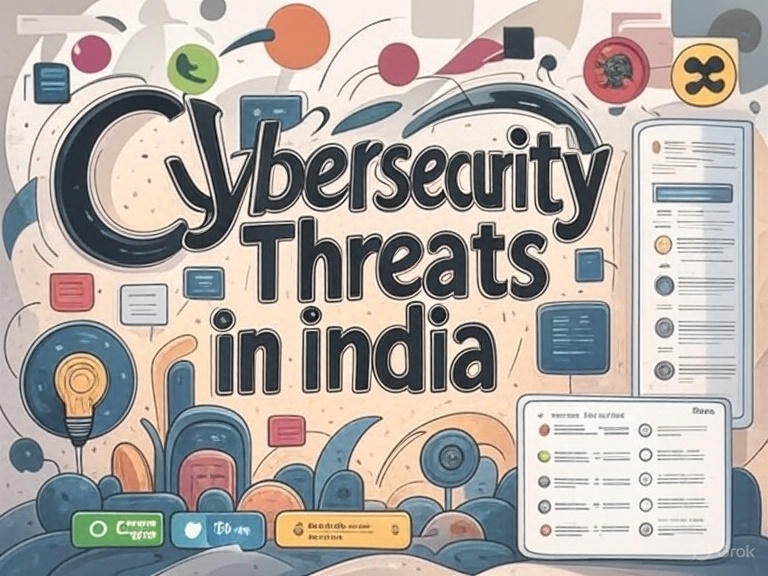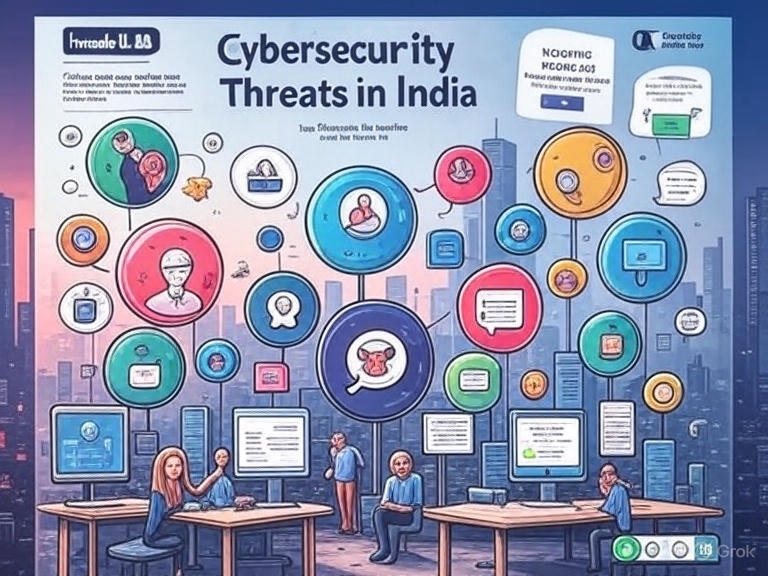
Table of Contents
- Ransomware Attacks
- Data Privacy and Data Breaches
- AI-Powered Cyber Attacks
- Phishing and Social Engineering
- 5G Network and IoT Security
- Cybercrime and Government Initiatives
- Attacks on Healthcare and Financial Sectors
- Infographics
- Interactive Quiz
- Conclusion
- Call to Action
- Frequently Asked Questions
- Hindi Summary
India is experiencing a rapid digital revolution, accompanied by rising cybersecurity threats. The increasing use of digital payments, 5G networks, and the Internet of Things (IoT) has opened new opportunities for cybercriminals. This article discusses the most searched cybersecurity topics in India, such as ransomware, phishing, and data breaches, and provides detailed solutions. Additionally, we will raise awareness through real-world examples, infographics, and an interactive quiz.
1. Ransomware Attacks
What is Ransomware?
Ransomware is a malicious virus that locks your data and demands payment (usually in cryptocurrency) to unlock it. In the first half of 2025, India ranked among the top three targets for ransomware attacks in the Asia-Pacific region, particularly in IT, banking, and manufacturing sectors.
Real-World Example:
In 2023, a ransomware attack on AIIMS Delhi disrupted hospital services and affected patient data.
Why is it a Concern?
- Economic Loss: Ransomware attacks cause millions or crores of rupees in damages to organizations.
- Data Loss: Critical data can be permanently lost without backups.
- Growing Threat: Ransomware-as-a-Service (RaaS) has made it more accessible.
Detailed Solutions:
- Regular and Offline Backups:
- What to Do: Regularly back up important data (documents, photos, software) and store it on an external hard drive or secure cloud.
- How to Do It: Use “File History” on Windows or “Time Machine” on Mac.
- Tip: Periodically check your backups to ensure they work.
- Use Security Software:
- What to Do: Install a reliable antivirus (e.g., Norton, McAfee, Bitdefender).
- How to Do It: Enable automatic updates and real-time scanning.
- Tip: Windows Defender is a good free option, but premium software offers extra protection.
- Employee Training:
- What to Do: Train employees to avoid suspicious emails, links, and attachments.
- How to Do It: Conduct workshops and use phishing simulation tools like KnowBe4.
- Tip: Advise employees not to download from unknown sources.
- Cyber Insurance:
- What to Do: Get cyber insurance to mitigate losses from attacks.
- How to Do It: Contact providers like ICICI Lombard or HDFC Ergo for policies covering ransomware and data recovery.
- Tip: Read policy terms and conditions carefully.
2. Data Privacy and Data Breaches
What is a Data Breach?
A data breach occurs when unauthorized individuals access your Aadhaar number, bank details, or personal information. In 2023, the data of 815 million Indians was leaked on the dark web.
Real-World Example:
In 2023, an ICMR data leak exposed the medical information of millions of Indians on the dark web.
Why is it a Concern?
- Identity Theft: Stolen data can be used for fraudulent loans or credit card misuse.
- Reputation Damage: Data breaches erode customer trust in organizations.
- Legal Consequences: Violations of the Digital Personal Data Protection Act (DPDPA) can result in heavy fines.
Detailed Solutions:
- Strong and Unique Passwords:
- What to Do: Create complex and unique passwords for each account.
- How to Do It: Use 12+ characters with uppercase, lowercase, numbers, and symbols. Use a password manager like LastPass.
- Tip: Avoid reusing passwords across accounts.
3. AI-Powered Cyber Attacks
What are AI Attacks?
Cybercriminals use artificial intelligence (AI) and machine learning (ML) to create deepfakes, sophisticated phishing, and automated viruses that can bypass traditional security.
Real-World Example:
In 2024, a company in India was tricked via a deepfake video call where a fake CEO instructed an employee to transfer millions of rupees.
Why is it a Concern?
- Deepfake Risks: Deepfake videos and audio can be used for fraud.
- Increasing Complexity: AI-based attacks are becoming faster and more effective.
- Hard to Detect: Regular users may not recognize these attacks easily.
Detailed Solutions:
- Deepfake Detection Tools:
- What to Do: Use AI tools to detect deepfake content.
- How to Do It: Install Sensity AI or Microsoft Video Authenticator.
- Tip: Verify suspicious content with multiple tools.
4. Phishing and Social Engineering
What is Phishing?
Phishing attacks involve cybercriminals using fake emails, SMS, or websites to steal passwords or bank details. The rise of UPI and online banking in India has made phishing more common.
Real-World Example:
In 2024, several UPI fraud cases emerged where users were lured into clicking fake UPI links via SMS.
Why is it a Concern?
- Financial Loss: Phishing leads to the theft of lakhs of rupees.
- Easy Targets: Regular users fall for fake links.
- Growing Sophistication: Social engineering techniques are becoming more advanced.
Detailed Solutions:
- Two-Factor Authentication (2FA):
- What to Do: Enable 2FA on all important accounts.
- How to Do It: Use Google Authenticator or SMS-based OTP.
- Tip: Hardware tokens like YubiKey are more secure.
5. 5G Network and IoT Security
What is 5G and IoT Security?
The high speed of 5G networks and the growing number of IoT devices (smart home appliances, smart meters) have increased cyber risks. Vulnerable IoT devices are easy targets for hackers.
Why is it a Concern?
- Network Risks: 5G can enable new types of attacks.
- IoT Vulnerabilities: Many IoT devices have default passwords or outdated software.
- Wide Impact: A single vulnerable device can compromise an entire network.
Detailed Solutions:
- Network Segmentation:
- What to Do: Divide your network into separate segments.
- How to Do It: Set up VLANs in your router settings.
- Tip: Use a guest network for IoT devices.
6. Cybercrime and Government Initiatives
Cybercrime Situation in India
Cybercrime incidents are rising rapidly in India. The Indian Cybercrime Coordination Centre (I4C) and Cyber Swachhta Kendra are actively addressing these threats.
Why is it a Concern?
- Rising Crime: Cybercriminals are targeting individuals and organizations.
- Lack of Awareness: Many people are unaware of the complaint filing process.
- Global Threat: India is a major target for global cyber attacks.
Detailed Solutions:
- Cybercrime Reporting:
- What to Do: Report cybercrime immediately.
- How to Do It: Call 1930 or file a complaint at cybercrime.gov.in.
- Tip: Save evidence like screenshots or emails.
7. Attacks on Healthcare and Financial Sectors
Threats to Healthcare and Financial Sectors
Healthcare and financial sectors are prime targets for ransomware and data breaches. The theft of patient or customer data can have severe consequences.
Real-World Example:
In 2024, a major Indian bank faced a ransomware attack that jeopardized customer confidential information.
Why is it a Concern?
- Sensitive Data: Medical and financial data fetch high prices on the dark web.
- Service Disruption: Ransomware can halt hospital or bank services.
- Ethical Issues: Data theft erodes customer trust.
Detailed Solutions:
- Cyber Resilience:
- What to Do: Implement a robust cybersecurity framework.
- How to Do It: Adopt ISO 27001 or NIST standards.
- Tip: Hire cybersecurity experts.
Infographics: A Quick Overview of Cybersecurity in India
- Ransomware Attacks: 30% of cyber attacks in India in 2025 were ransomware-related.
- Data Breaches: Data of 815 million Indians was leaked in 2023.
- Phishing: UPI-related phishing attacks increased by 40% in 2024.
- Tip: Use strong passwords, 2FA, and regular backups.
(Note: Create infographics using Canva or Adobe Express and add them with an <img> tag.)
Conclusion
Cybersecurity is a serious and growing issue in India. Ransomware, data breaches, AI-powered attacks, phishing, 5G and IoT risks, cybercrime, and attacks on healthcare and financial sectors are among the most searched topics. With our detailed solutions, real-world examples, and interactive elements, you can protect your digital life.
Call to Action
- Subscribe to Newsletter: Click here
- Download Free Checklist: Download here
- Read More Articles: Explore “UPI Fraud Prevention” and “IoT Security Tips.”
Frequently Asked Questions (FAQ)
- How do I know if my device is affected by ransomware? Answer: Files will be locked, and a ransom message will appear. Disconnect from the network, contact an expert, and restore data from backups.
- How do I identify phishing emails? Answer: Check for spelling errors, urgent language, or suspicious links. Hover over links to verify URLs and log in manually on official websites.
- What should I do if there’s a data breach? Answer: Change passwords, enable 2FA, notify your bank, and file a complaint at cybercrime.gov.in.
- How can I secure my IoT devices? Answer: Change default passwords, place devices on a guest network, and update firmware.
- How do I report cybercrime in India? Answer: Call 1930 or file a complaint at cybercrime.gov.in. Save evidence.
- How can I avoid deepfakes? Answer: Use deepfake detection tools and verify suspicious content through alternative channels.
- What is DPDPA? Answer: The Digital Personal Data Protection Act (DPDPA) 2023 regulates data privacy and gives users control over their data.
Hindi Summary
भारत में साइबर सुरक्षा एक गंभीर और बढ़ता हुआ मुद्दा है। रैनसमवेयर, डेटा उल्लंघन, AI-संचालित हमले, फिशिंग, 5G और IoT जोखिम, साइबर अपराध, और हेल्थकेयर व वित्तीय क्षेत्रों पर हमले सबसे अधिक खोजे जाने वाले विषय हैं।
Share this article:WhatsApp Twitter LinkedIn
![]()

Leave a Reply